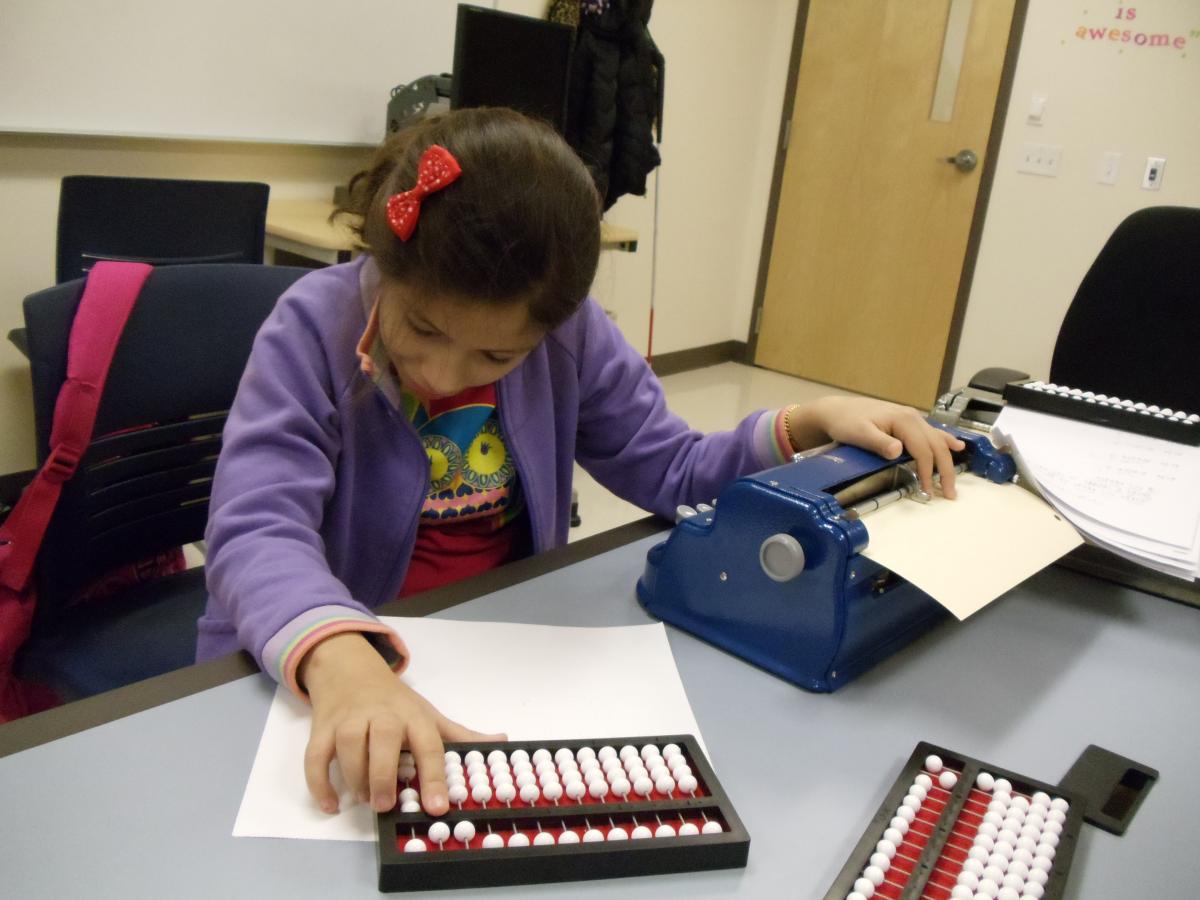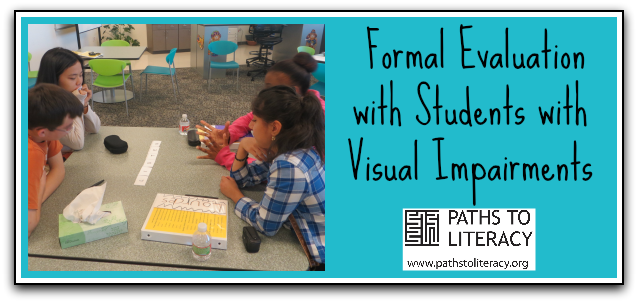The Next Step in Intervention: Formal Evaluation
Submitted by Marnee Loftin on Sep 08, 2015
Many struggling readers will improve skills as the result of intervention or maturity. However, struggling readers may also show little improvement over time. By the age of 9 years or approximately third grade, improvements will need to be obvious. The student may still be struggling, but the gap should have narrowed between his/her performance and peers. If these improvements are not present, it is important that formal evaluation occur to determine what other issues might be present. In most instances another condition will also be affecting the child’s ability to learn.
Formal evaluation can be a stressful process for the TVI (Teacher of the Visually Impaired), parent, and the student. Each of these individuals will be most successful if they have a clear idea of what is to occur as well as the reason for each step.
Typically the evaluation is completed most often by a school psychologist. This person will not know the student personally and has limited information about visual impairment. Because visual impairment is such a low incidence disability, the school psychologist may not have even worked with a student with visual impairment. Conversely, the TVI and parent will have limited information about the evaluation process. Most parents have some skepticism that such an evaluation will provide good information about their child. A meaningful evaluation will only occur if each of these individuals (TVI, parent, and psychologist) will communicate about the process before, during and after the evaluation. This communication ensures that everyone has the best possible information about the student as well as the process.
The TVI provides information about:
- The visual impairment and how it affects learning and development of concepts
- Accommodations and LV (low vision) devices that are approved for use
- List of reading materials and references that relate to evaluation of students with visual impairment
- Specific educational or emotional/behavioral problems that have been noted
- Specific interventions that have been attempted and the success of these interventions
- Clear statement of specific educational concerns and how it does/does not relate to vision
The parent provides information about:
- Early physical history including pregnancy and birth
- Hospitalizations or serious illnesses
- Developmental milestones
- Educational history
- Specific skills demonstrated at home
- Specific problems or concerns apparent at home
- Family history of learning problems
- Copies of any specialized evaluations completed privately
The evaluation specialist provides information about:
- Timeline for the evaluation
- Purpose of tests that will be administered
- Realistic timeframe for completion of the evaluation as well as report
- Different types of instruments that will be administered
- Any observations in the classroom or at home
Each of these people will benefit from an opportunity to talk together informally before the evaluation starts. Questions can be addressed. Answers can be clarified. Such meetings will ensure that communication is open throughout the process.
In almost 30 years of experience as a school psychologist at Texas School for the Blind and Visually Impaired, I found that I could usually obtain this information from the TVI and the parent. I was conscientious about trying to provide my own pieces of information. What usually created the stress during an evaluation were the myths regarding psychoeducational evaluations! Few of us are willing to talk about myths, but they constantly effect our beliefs as well as our actions. The following list of myths and some information may generate some more open discussions during the evaluation process.
Myth #1: The law specifically forbids the evaluation of students with visual impairments because the evaluator cannot “rule out” the impact of the visual impairment.
Laws do make it very clear that we need to be certain that the visual impairment is not the “primary” cause of the educational problems. The TVI is the person that is responsible for determining that appropriate intervention has occurred and that visual impairment is not the primary cause of the educational problem. For example, a child who simply needs glasses to read the math problems on the board would be considered to have an educational problem that is primarily the result of a vision problem. Staff in schools are well trained to note this type of problem and provide appropriate intervention. Simply providing glasses to this child will allow them to see the problem and solve it correctly.
In the other case, a child with a visual impairment has already been provided appropriate intervention through the services of the TVI. As discussed in earlier posts, the TVI has already provided additional intervention to help with problems that are noted. This process ensures that vision is not the “primary” cause of the educational problems noted.
Myth #2: Formal psychoeducational testing provides little useful information about children with visual impairment.
Most psychologists who work exclusively in the field of visual impairment feel that formal testing provides important information about all children. It is important that the evaluator administer these tests as recommended in several books that deal with best practice guidelines, and that appropriate cautions be observed and noted. It is also important that the evaluator have information about specific instruments that were developed for use with children with visual impairments. With careful administration and interpretation as well as communication with the TVI, formal evaluations can yield some important information. This information is invaluable in making decisions.
 Myth #3: It is critical that the psychologist have knowledge and experience in evaluating the child with visual impairment prior to testing my child.
Myth #3: It is critical that the psychologist have knowledge and experience in evaluating the child with visual impairment prior to testing my child.
As caring adults, we would all prefer that a psychologist have specific experience with children who have characteristics similar to the child that we love! However, it is important to note that this seldom happens. Even in a situation in which a psychologist works exclusively with children with visual impairments, the complexity of this group is an ongoing challenge. Psychologists are trained and ethically required to gather information that will affect the process of evaluating a particular child. For children with low incidence conditions, psychologists will often depend upon the parent and the teachers to help guide them to appropriate reference materials. The parent and TVI can be helpful in directing the psychologist to appropriate materials discussing best practice guidelines for evaluation of children with VI (visual impairment). It is also critical that the TVI be available to discuss the accommodations and adaptive devices that are used during instruction. The psychologist will then determine those that can be used during the evaluation. For example, an abacus may be used during instruction but would likely not be allowed during an evaluation measuring skills in mental mathematics.
Myth #4: The presence of a familiar adult during the evaluation will help the child do better on the tests.
On rare occasions the presence of the TVI or parent may be requested to help a child who is extremely uncomfortable with unfamiliar adults. It may also be necessary when a number of idiosyncratic behaviors or language may limit understanding of the psychologist, thereby affecting results. However, this is the exception rather than the rule. The evaluator is trained in different ways to make a child feel comfortable, and is very aware of the importance of establishing a relationship with the child. If this does not occur, the evaluator will ask for help from the adults present. The ability to interact comfortably with unfamiliar adults is an important skill to assess. Give your child the opportunity to develop and demonstrate this skill.
Parents and the TVI can assist with making the child feel comfortable by introducing them to the psychologist. Help explain the process, briefly settle the child into the environment and then leave. It will be important to remain close in an adjoining area in case of problems, but encourage your child to be independent in this situation.
Myth #5: Growth in any areas will result in improved performance on all types of psychoeducational evaluations.
In my professional experience, one of the more frustrating situations is that in which the child has clearly learned a great deal since the time of the last assessment. Skills have improved; behavior has become more goal-focused. Yet formal evaluation reveals little improvement. For a psychologist, this is not unexpected; for a TVI and a parent this situation can be devastating.
It is important to remember the ways that formal tests are constructed. They are developed so particular items represent behaviors that are typical of students at a particular age or grade. Expectations continue to change as the child becomes older. Thus, a child who is 8 years old can be performing at the age of a 6 year old when first tested. During the next three years, this child can learn an incredible number of skills and be performing as a 9 year old, i.e. three years of learning in three years of time. However, now the behaviors that are being used for comparison are those of an 11 year old. The gap between the performance of the child and the expectations for performance continue to be present. In very rare instances, a child will be able to close those gaps. However, it is almost always the result of extreme deprivation during early years or an untreated mental illness.
Rather than expecting a true “catch up” situation, it is important that all adults celebrate the incredible progress that has actually been made by this child.
Myth #6: All types of learning problems can be identified and appropriate techniques developed for effective intervention.
On some occasions the evaluator will not be able to determine the exact types of educational problems that are being experienced by a child. On other occasions, another condition is the reason for the educational delays and learning problems. Many of the children who are referred for evaluation of possible learning disabilities actually have cognitive limitations. They may have intellectual disabilities. They may also have intellectual abilities that are slightly below average, often referred to as borderline intelligence. For both of these groups, acquiring educational skills will be difficult. Specialized teaching techniques will help these children learn, but most frequently acquiring skills beyond the third grade level will be quite difficult.
Evaluators are often frustrated by those children who have average intelligence, good educational services, and strong motivation for learning….but simply don’t learn. Our emphasis with these children must be on determining appropriate techniques using a strong multidisciplinary approach. Sometimes no answers appear in spite of comprehensive evaluations.
Clear communication between parents, TVI, and psychologist before, during, and after the evaluation will result in a quality evaluation of the child with visual impairment. Much of this communication will simply be the exchange of information between all individuals. However, it is equally important that each person discuss their own fears and concerns to ensure the best possible evaluation. Evaluation can form the base for intervention that will help a child achieve at their highest potential, an important goal for each of us.

